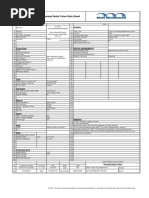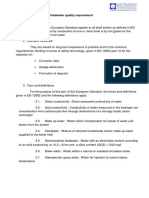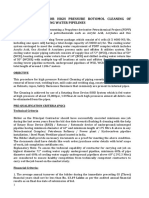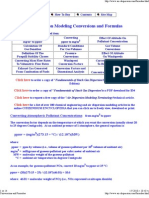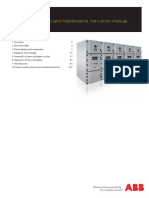Conversions and Formulas
Uploaded by
Bernie_Garcia__9886Conversions and Formulas
Uploaded by
Bernie_Garcia__98866/15/13
Conversions and Formulas
Home
How To Buy
Contents
Site Map
Air Dispersion Modeling Conversions and Formulas
Click in table below on desired item: Converting mg/m3 to ppmv Calculation Of Gas Densities Definition Of The Pasquill Stability Classes Converting Mass Flow Rates To Volumetric Flow Rates Exhaust Gas Generated From Combustion of Fuels Converting ppmv to mg/m3 Standard Conditions For Gas Volumes Pressure Conversions Windspeed Conversion Factors Conversion Factors and Dimensional Analysis Effect Of Altitude On Pollutant Concentration Gas Volume Conversions Effect Of Altitude On Windspeeds Correcting Concentrations To Reference Conditions Appendix A Concentration Units (ppm, mg/m3 )
Converting Atmospheric Pollutant Concentrations: from mg/m3 to ppmv
The conversion factor depends on the temperature at which you want the conversion (usually about 20 to 25 degrees Centigrade). At an ambient pressure of 1 atmosphere, the general equation is:
ppmv = (mg/m3)(273.15 + C) / (12.187)(MW)
where: ppmv = mg/m3 = MW = C = ppm by volume (i.e., volume of gaseous pollutant per 106 volumes of ambient air) milligrams of gaseous pollutant per cubic meter of ambient air molecular weight of the gaseous pollutant ambient air temperature in degrees Centigrade
As an example, for gaseous pollutant NOx, convert 20 mg/m3 to ppmv at 25 C: ppmv = (20)(273.15 + 25) / (12.187)(46.01) = 10.6 where: 46.01 = molecular weight of NO2 (i.e., NOx expressed as nitrogen dioxide) NOTES: (1) The pollution laws and regulations in the United States typically reference their pollutant limits to an ambient temperature of 20 to 25 C as noted above. However, in other nations, the reference
www.air-dispersion.com/formulas.html#volume 1/15
6/15/13
Conversions and Formulas
ambient temperature for pollutant limits may be 0 C or other values. (2) 1 percent by volume = 10,000 ppmv (i.e., parts per million by volume). (3) For all practical purposes, degrees Centigrade and degrees Celsius are synonymous.
Return to Top
Converting Atmospheric Pollutant Concentrations: from ppmv to mg/m3
The conversion factor depends on the temperature at which you want the conversion (usually about 20 to 25 degrees Centigrade). At an ambient pressure of 1 atmosphere, the general equation is:
mg/m3 = (ppmv)(12.187)(MW) / (273.15 + C)
where: mg/m3 = ppmv = MW = C = milligrams of gaseous pollutant per cubic meter of ambient air ppm by volume (i.e., volume of gaseous pollutant per 106 volumes of ambient air) molecular weight of the gaseous pollutant ambient air temperature in degrees Centigrade
As an example, for gaseous pollutant NOx, convert 20 ppmv to mg/m3 at 25 C: mg/m3 = (20)(12.187)(46.01) / (273.15 + 25) = 37.6 where: 46.01 = molecular weight of NO2 (i.e., NOx expressed as nitrogen dioxide) NOTES: (1) The pollution laws and regulations in the United States typically reference their pollutant limits to an ambient temperature of 20 to 25 C as noted above. However, in other nations, the reference ambient temperature for pollutant limits may be 0 C or other values. (2) 1 percent by volume = 10,000 ppmv (i.e., parts per million by volume). (3) For all practical purposes, degrees Centigrade and degrees Celsius are synonymous.
Return to Top
Effect of Altitude on Atmospheric Pollutant Concentrations:
Atmospheric pollutant concentrations expressed as mass per unit volume of atmospheric air (e.g., mg/m3 , ug/m3 , etc.) at sea level will decrease with increasing altitude because the atmospheric pressure decreases with increasing altitude. The change of atmospheric pressure with altitude can be obtained from this equation:
www.air-dispersion.com/formulas.html#volume 2/15
6/15/13
Conversions and Formulas
Pa = 0.9877a
Given an atmospheric pollutant concentration at an atmospheric pressure of 1 atmosphere (i.e., at sea level altitude), the concentration at other altitudes can be obtained from this equation:
Ca = (C)(0.9877a)
where: a = altitude, in 100's of meters Pa = atmospheric pressure at altitude a, in atmospheres C = concentration at sea level altitude, in mass per unit volume Ca = concentration at altitude a, in mass per unit volume As an example, given a concentration of 260 mg/m3 at sea level, calculate the equivalent concentration at an altitude of 1,800 meters: Ca = (260)(0.987718 ) = 208 mg/m3 at 1,800 meters altitude
Return to Top
Calculation Of Gas Densities:
The following equation for the density of a gas in pounds per cubic foot is derived from the ideal gas law and the applicable universal gas constant:
pounds per cubic foot = ( 1 / Z )( MW / 10.73 )( psia / R )
The following equations for the density of a gas in kilograms per cubic meter are also derived from the ideal gas law and the applicable universal gas constants ... one of the equations uses the absolute pressure expressed in atmospheres and the other uses the absolute pressure expressed in kilopascals:
kilograms per cubic meter = ( 1 / Z )( MW / 0.082057 )( atm / K ) kilograms per cubic meter = ( 1 / Z )( MW / 8.3144 )( kPa / K )
where:
www.air-dispersion.com/formulas.html#volume 3/15
6/15/13
Conversions and Formulas
Z = gas compressibility factor at the given temperature and pressure (dimensionless) MW = molecular weight of the gas psia = absolute pressure in pounds per square inch atm = absolute pressure in atmospheres kPa = absolute pressure in kilopascals 1 atm = 14.696 psia = 101.325 kPa R = absolute temperature of the gas in degrees Rankine = 459.67 + F K = absolute temperature of the gas in degrees Kelvin = 273.15 + C F = degrees Fahrenheit = ( 1.8 ) ( C ) + 32 C = degrees Centigrade = ( F - 32 ) / 1.8 The numbers 10.73, 0.082057, and 8.3144 are all the universal gas law constant expressed in the applicable units for each of the above equations. For all practical purposes, degrees Centigrade and degrees Celsius are synonymous. Also, in many cases, it may be assumed that the ideal gas law applies and thus Z may be taken to be 1.00. The technical literature can be very confusing because many authors fail to explain whether they are using the universal gas law constant R which applies to any ideal gas or whether they are using the gas law constant Rs which only applies to a specific individual gas. The relationship between the two constants is Rs = R / (MW).
Return to Top
Standard Conditions For Gas Volumes:
A normal cubic meter (Nm3 ) is the metric expression of gas volume at standard conditions and it is usually defined as being measured at 0 C and 1 atmosphere of pressure. A standard cubic foot (scf) is the USA expression of gas volume at standard conditions and it is very often defined as being measured at 60 F and 1 atmosphere of pressure. There are other definitions of standard gas conditions used in the USA besides 60 F and 1 atmosphere, but that is the most common one ... and it is very widely used in the oil, gas and hydrocarbon processing industries. That being understood:
1 Nm3 of any gas (measured at 0 C and 1 atm. pressure) equals 37.326 scf of that gas (measured at 60 F and 1 atm. pressure) ... and thus 1 Nm3 per hour of any gas equals 0.622 scf per minute of that gas. 1 kg-mol of any ideal gas equals 22.414 Nm3 of that gas ... and 1 lb-mol of any ideal gas equals 379.482 scf of that gas.
Return to Top
www.air-dispersion.com/formulas.html#volume 4/15
6/15/13
Conversions and Formulas
Gas Volume Conversions:
To convert air or other gas volumes from one pressure (P1 ) and temperature (T1 ) to another pressure (P2 ) and temperature (T1 ), use the following equation:
V2 / V1 = ( Z 2 / Z 1 ) ( P1 / P2 ) ( T2 / T1 )
where: Z 1 and Z 2 = gas compressibility factors (which are non-dimensional) V1 and V2 = gas volumes in the same dimensional units P1 and P2 = absolute pressures in the same dimensional units T1 and T2 = absolute temperatures in the same units (either degrees R or degrees K ) R = absolute temperature in degrees Rankine = 459.67 + F K = absolute temperature in degrees Kelvin = 273.15 + C F = degrees Fahrenheit = ( 1.8 ) ( C ) + 32 C = degrees Centigrade = ( F - 32 ) / 1.8 For all practical purposes, degrees Centigrade and degrees Celsius are synonymous. Also, in many cases, it may be assumed that the ideal gas law applies and thus Z may be taken to be 1.00.
Return to Top
Definition Of The Pasquill Stability Classes:
The amount of turbulence in the ambient air has a major effect upon the rise and dispersion of air pollutant plumes. The amount of turbulence can be categorized into defined increments or "stability classes". The most commonly used categories are the Pasquill stability classes A, B, C, D, E, and F. Class A denotes the most unstable or most turbulent conditions and Class F denotes the most stable or least turbulent conditions. The Pasquill stability classes are presented below as they are defined by the prevailing meteorological conditions of: (a) surface windspeed measured at 10 meters above ground level and (b) day-time incoming solar radiation or the night-time percentage of cloud cover. Surface Windspeed m/s <2 2-3 mi/hr <5 5-7 Daytime Incoming Solar Radiation Strong A A-B Moderate A-B B Slight B C Night-time Cloud Cover > 50% E E < 50% F F
5/15
www.air-dispersion.com/formulas.html#volume
6/15/13
Conversions and Formulas
3-5 5-6 >6
7-11 11-13 >13
B C C
B-C C-D D
C D D
D D D
E D D
Note: Class D applies to heavily overcast skies, at any windspeed day or night. NOTES: (1) m/s = meters per second (2) mi/hr = statute miles per hour
Return to Top
Pressure Conversions:
Atmospheric pressures may be expressed in a number of different units. The following table provides the conversions between six of the most commonly used units of pressure. Here are some examples as read from the table: (1) 1 atmosphere = 14.696 psi or 101.325 kPa (2) 1 bar = 0.986923 atmospheres or 750.0616 mm Hg (3) 1 psi = 6.894733 kPa or 51.71475 mm Hg atm 1 atm = 1 psi = 1 kPa = 1 bar = 1 mm Hg = 1 kg/cm2 = 1 0.068046 0.009869 0.986923 0.001316 0.967841 psi 14.696 1 0.145038 14.50382 0.019337 14.22339 kPa 101.325 6.894733 1 100.0000 0.133322 98.0665 bar 1.01325 0.068947 0.010000 1 0.001333 0.980665 mm Hg 760 51.71475 7.500617 750.0616 1 735.559 kg/cm2 1.033228 0.070307 0.010197 1.019716 0.001360 1
Although not included in the above table: 1 atmosphere of pressure = 33.90 feet of water = 10.33 meters of water 1 mm Hg = 1 torr Notes: atm = absolute pressure, in atmospheres psi = absolute pressure, in pounds per square inch kPa = absolute pressure, in kilopascals bar = absolute pressure, in bars mm Hg = absolute pressure, in millimeters of Mercury kg/cm2 = absolute pressure, in kilograms per square centimeter
www.air-dispersion.com/formulas.html#volume
6/15
6/15/13
Conversions and Formulas
Return to Top
Effect of Altitude on Windspeeds:
The winds aloft generally have a higher velocity than the winds at ground level. In other words, at any given time and place, windspeed usually increases with altitude. The effect of altitude on windspeed involves two factors: the degree of turbulent mixing prevailing in the atmosphere at the given time and place, as characterized by the Pasquill stability class the terrain's surface area roughness, which induces surface friction at the given place It has generally been agreed that the effect of altitude on windspeed is logarithmic and can be expressed as:
uz / ug = (hz / hg)n
where: uz = wind velocity at height z ug = wind velocity at ground station height hz = height z hg = ground station height (usually 10 meters) : n = a function of the Pasquill stability class and the terrain type (see tables below) Table 1 For Use In Rural Terrain Stability A B C D E F Exponent n 0.10 0.15 0.20 0.25 0.25 0.30 Table 2 For Use In Urban Terrain Stability A B C D E F Exponent n 0.15 0.15 0.20 0.25 0.40 0.60
As an example, given a windspeed of 5 m/s measured at 10 meters above the ground and a stability class of B in rural terrain, calculate the windspeed at 500 meters above ground: uz = (5)(500/10)0.15 = 9 m/s
Return to Top
www.air-dispersion.com/formulas.html#volume 7/15
6/15/13
Conversions and Formulas
Converting Mass Flow Rates To Volumetric Flow Rates:
Gaseous emission flow rates (from process vents, combustion flue gases from furnaces or boilers, accidental gaseous releases, etc.) are often expressed in mass flow rates. To convert such mass flow rates to volumetric flow rates, first calculate the gas density (as explained in one of the sections above) using the actual temperature and pressure of the gaseous emission. Then use either of the following equations:
ft3 / hr = ( lbs / hr ) / ( lbs / ft3 )
where: ft3 / hr = gas volumetric flow rate in cubic feet per hour lbs / hr = gas mass flow rate in pounds per hour lbs / ft3 = gas density in pounds per cubic foot
m3 / hr = ( kg / hr ) / ( kg / m3 )
where: m3 / hr = gas volumetric flow rate in cubic meters per hour kg / hr = gas mass flow rate in kilograms per hour kg / m3 = gas density in kilograms per cubic meter Note: When calculating the density of the gaseous emission, the actual pressure of the gaseous emission at the point where it exits from the source vent or flue gas stack is taken as 14.696 psia or 1 atmospere.
Return to Top
Windspeed Conversion Factors:
Meteorological data includes windspeeds which may be expressed as statute miles per hour, knots, or meters per second. Here are the conversion factors for those various expressions of windspeed:
1 knot = 1.152 statute mi/hr = 0.515 m/sec 1 statute mi/hr = 0.868 knots = 0.447 m/sec 1 m/sec = 2.237 statute mi/hr = 1.942 knots
Note:
www.air-dispersion.com/formulas.html#volume 8/15
6/15/13
Conversions and Formulas
1 statute mile = 5,280 feet = 1,609 meters
Return to Top
Correcting Concentrations to Reference Conditions in Regulated Emission Limits:
Many environmental protection agencies have issued regulations that limit the concentration of pollutants in gaseous emissions and define the reference conditions applicable to those concentration limits. For example, such a regulation might limit the concentration of NOx to 55 ppmv in a dry combustion exhaust gas corrected to 3 volume percent O2 . As another example, a regulation might limit the concentration of particulate matter to 0.1 grain per standard cubic foot (i.e., scf) of dry exhaust gas corrected to 12 volume percent CO2 . A standard cubic foot of dry gas is often denoted as "dscf" or as "scfd". Likewise, a standard cubic meter of dry gas is often denoted as "dscm" or "scmd" by environmental agencies in the USA.
Correcting Concentrations to a Dry Basis:
If a gaseous emission sample is analyzed and found to contain water vapor and a pollutant concentration of X, then X should be designated as the "wet basis" pollutant concentration. The following equation can be used to correct the measured "wet basis" concentration to a "dry basis" concentration:
(1)
dry basis concentration = ( wet basis concentration ) / ( 1 - w )
where: w = fraction of the emitted exhaust gas, by volume, which is water vapor Thus, a wet basis concentration of 40 ppmv in an emitted gas containing 10 volume percent water vapor would have a dry basis concentration = ( 40 ) / ( 1 - 0.10 ) = 44.44 ppmv.
Correcting Concentrations to a Reference O2 Content in the Emitted Gas:
The following equation can be used to correct a measured pollutant concentration in an emitted gas (containing a measured O2 content) to an equivalent pollutant concentration in an emitted gas containing a specified reference amount of O2 :
(2)
Cr = Cm ( 20.9 - r ) / ( 20.9 - m )
where: Cr = corrected concentration in dry emitted gas having the reference volume % O2 = r Cm = measured concentration in dry emitted gas having the measured volume % O = m 2
www.air-dispersion.com/formulas.html#volume 9/15
6/15/13
Conversions and Formulas
Thus, a measured nitrogen oxides (i.e., NOx) concentration of 45 ppmv (dry basis) in an emitted gas having 5 volume % O2 = ( 45 ) ( 20.9 - 3 ) / ( 20.9 - 5 ) = 50.7 ppmv (dry basis) when corrected to an emitted gas having a specified reference O2 content of 3 volume %.
Correcting Concentrations to a Reference CO2 Content in the Emitted Gas:
The following equation can be used to correct a measured pollutant concentration in an emitted gas (containing a measured CO2 content) to an equivalent pollutant concentration in an emitted gas containing a specified reference amount of CO2 :
(3)
Cr = Cm ( r / m )
where: Cr = corrected concentration in dry emitted gas having the reference volume % CO2 = r Cm = measured concentration in dry emitted gas having the measured volume % CO2 = m And thus, a measured particulate matter concentration of 0.1 grain per dscf in an emitted gas that has 8 volume % CO2 = ( 0.1 ) ( 12 / 8 ) = 0.15 grain per dscf when corrected to an emitted gas having a specified reference CO2 content of 12 volume %. Notes: -- Although ppmv and grains per dscf have been used in the above examples, you may use other concentrations such as ppbv (i.e., parts per billion by volume), volume percent, grams per dscm, etc. -- 1 percent by volume = 10,000 ppmv (i.e., parts per million by volume). -- Equation (1) above is from "40 CFR, Chapter I, Part 60, Appendix A-3, Test Method 4". -- Equation (2) above is from "40 CFR, Chapter I, Part 60, Appendix B, Performance Spec. 2". -- Equation (3) above is from "40 CFR, Chapter I, Part 60".
Return to Top
Exhaust Gas Generated From Combustion of Fuels:
It is often useful to have a good estimate of the amount of exhaust gas or flue gas generated by the combustion of a fuel and of the O2 and CO2 content of the gas. Here are some typical values: Fuel Gas 1,093 150,000
10/15
Combustion Data: Higher heating value, Btu / scf Higher heating value, Btu / gallon
www.air-dispersion.com/formulas.html#volume
Fuel Oil
Coal
6/15/13
Conversions and Formulas
Higher heating value, Btu / pound Molecular weight Gravity, API Carbon / hydrogen ratio by weight Weight % carbon Weight % hydrogen Weight % oxygen Weight % sulfur Weight % nitrogen Weight % ash Weight % moisture Excess combustion air, % Amount of wet exhaust gas, scf / MMBtu of fuel CO2 in wet exhaust gas, volume % O2 in wet exhaust gas, volume % Molecular weight of wet exhaust gas Amount of dry exhaust gas, scf / MMBtu of fuel CO2 in dry exhaust gas, volume % O2 in dry exhaust gas, volume % Molecular weight of dry exhaust gas 12 11,600 8.8 2.0 27.7 9,510 10.8 2.5 29.9 15 11,930 12.4 2.6 29.0 10,600 14.0 2.9 30.4 18 15.5 8.1
8,020
47.9 3.4 10.8 0.9 0.6 6.0 30.4 20 13,985 13.5 3.3 29.0 12,130 15.5 3.8 30.8
Converting the Exhaust Gas Amounts to Other Units:
The amount of fuel combusted may be expressed in MMBtu, or in MMkcal, or in MW-hr ... and the amount of combustion exhaust gas may be expressed as standard cubic feet (scf) or as Normal cubic meters (Ncm or Nm3 ). These are the definitions and equivalents involved in converting the exhaust gas amounts from scf / MMBtu to other units: (a) 1 MMBtu = 106 Btu (b) 1 MMkcal = 106 kilogram-calories (c) 1 MW-hr = 1 megawatt-hour = 106 watt-hours (d) 1 MMBtu = 0.252 MMkcal = 0.293 MW-hr (e) 1 MMkcal = 3.968 MMBtu = 1.163 MW-hr (f) 1 MW-hr = 3.413 MMBtu = 0.860 MMkcal (g) scf = standard cubic feet measured at 60 F and atmospheric pressure (h) Nm3 = Normal cubic meters measured at 0 C and atmospheric pressure
www.air-dispersion.com/formulas.html#volume 11/15
6/15/13
Conversions and Formulas
(i) 1 Nm3 = 37.326 scf These are the resulting conversions from scf / MMBtu to other units:
1 scf / MMBtu = 0.1063 Nm3/ MMkcal = 0.0914 Nm3/ MW-hr
Notes: -- Reference temperatures (other than those above) are used to define standard cubic feet and Normal cubic meters, but those given above are widely used. As an example, the USA's Environmental Protection Agency uses 68 F ( 20 C ) as the reference temperature for both standard cubic feet ( scf ) and standard cubic meters ( scm ) ... whereas most of the oil and gas industries worldwide generally use 60 F to define scf, and all of the metric nations use the term Normal m3 (rather than scm) with a reference temperature of 0 C ( rather than 20 C ) . -- The dry and wet exhaust gas volumes given above differ somewhat from the U.S. EPA's corresponding F Factors ( see publication EPA-454/R-95-015, Revised ) because: ( a ) the EPA's F Factors are all at 0 % excess combustion air, ( b ) the EPA's reference temperature for scf is 68 F rather the 60 F used above, and ( c ) the fuel compositions that were used for the EPA's F Factors probably differ from those used above. -- In the case of MW-hr, the M is an abbreviation for 106 ... whereas in the case of MMBtu and MMkcal, M is an abbreviation for 103 . This is an unfortunate irregularity, but one which is actually in use.
Return to Top
Conversion Factors and Dimensional Analysis:
Every physical measurement consists of a numerical quantity and a corresponding dimensional unit (for example: 1000 kg / m3 , 50 miles / hour, 1000 Btu / lb, etc). Whenever it is necessary to convert a physical measurement from one dimensional unit to another, dimensional analysis (also known as the unit-factor method or the factor-label method) is quite useful. But what is dimensional analysis in the context of converting dimensional units? It is the sequential usage of various conversion factors expressed as fractions and arranged so that any dimensional unit appearing in both the numerator and denominator of any of the fractions can be cancelled out until only the desired set of dimensional units is obtained. For example, let us convert 10 miles per hour to meters per second: 10 mile 1609 meter 1 hour 4.47 meter = 1 hour 1 mile 3600 second second
www.air-dispersion.com/formulas.html#volume 12/15
6/15/13
Conversions and Formulas
As can be seen, when the mile dimensions and the hour dimensions are cancelled out and the arithmetic is done, we have converted 10 miles per hour to 4.47 meters per second. As another example, convert the ppmv of NOx in an exhaust gas (denoted as C) to grams per hour of NOx, given the molecular weight of NOx as 46.01, and the rate of exhaust in scf per minute (denoted as E): C, scf E, scf exhaust 60 minute 46.01 lb 453.6 grams 1 lb-mole grams = 106 scf exhaust hour 1 minute 1 hour 1 lb-mole 1 lb 379.48 scf
As shown in the above equation, after cancelling out any dimensional units that appear both above and below the division lines, the only remaining units are grams / hour. Thus: grams / hour of NOx = (C, ppmv of NOx) (E, scf of exhaust / minute) / 303.05 Note: A standard cubic foot (scf) is the USA expression of gas volume at 60 F and 1 atmosphere of pressure and, using that definition, there are 379.48 scf per pound-mole of any gas. There are other definitions of standard gas conditions used in the USA besides 60 F and 1 atmosphere, but this is the most common one. The same example, using metric units: C, Nm3 E, Nm3 exhaust 60 minute 46.01 grams 1 g-mole grams = 106 Nm3 exhaust 1 minute 1 hour 1 g-mole 0.02214 Nm3 hour
As shown in the above equation, after cancelling out any dimensional units that appear both above and below the division lines, the only remaining units are grams / hour. Thus: grams / hour of NOx = (C, ppmv of NOx) (E, Nm3 of exhaust / minute) / 8.12 Note: A normal cubic meter (Nm3 ) is the usual metric system expression of gas volume at 0 C and 1 atmosphere of pressure and, using that definition, there are 0.02214 Nm3 per gram-mole of any gas. Dimensional analysis can also be used to check the correctness of any mathematical equation involving dimensional units by checking to see that the dimensional units on the left hand side of the equation are the same as the dimensional units on the right hand side of the equation.
Return to Top
www.air-dispersion.com/formulas.html#volume 13/15
6/15/13
Conversions and Formulas
Appendix A: Concentration Units: ( ppm and mg/m3 )
(1) The term ppm is an acronym for parts per million. In the context of airborne gaseous pollutant concentrations, it stands for volumes of gaseous pollutant X per million volumes of air. As discussed further below, it is very important to use the terms ppmv or ppm by volume rather than simply ppm. Some airborne gaseous pollutant concentrations may be expressed as ppbv or ppb by volume, meaning volumes of gaseous pollutant per billion volumes of air. (2) For an airborne gaseous or non-gaseous pollutant concentration, the term mg/m3 stands for milligrams of substance X per cubic meter of air. Some airborne gaseous or non-gaseous pollutant concentrations may be expressed as ug/m3 , which stands for microgams of substance X per cubic meter of air. (3) The hazardous concentration limits set by NIOSH, OSHA and ACGIH are for the most part directed at airborne pollutants (i.e., gases, vapors, dusts, aerosols, and mists). Hazardous substances dissolved in water or any other liquid are generally not within the purview of NIOSH, OSHA and ACGIH. (4) Airborne pollutant concentration limits are usually expressed as parts per million by volume (i.e., ppmv) for gases and vapors, and mg/m3 for dusts, aerosols and mists. (5) Quite often you will find the hazardous concentration limit of an airborne gaseous pollutant expressed as either ppmv or mg/m3 or both. There is a simple mathematical method of converting one to the other for gaseous substances (as given earlier in this article). However, for non-gaseous pollutants such as dusts, mists or aerosols, it would be very difficult, if not impossible, to convert mg/m3 to ppmv. (6) When dealing with hazardous substances dissolved in water or any other liquid, most chemists would use the term parts per million by weight (i.e., ppmw) as meaning weight of dissolved substance X per million weights of liquid ... where the weight units might be in milligrams (mg) or grams (g) or pounds (lb) or kilograms (kg). In a few cases, chemists might use ppmv as meaning volumes of gas or liquid dissolved in water or other liquid per million volumes of water or other liquid. For example, gaseous carbon dioxide dissolved in water ... or liquid acetone dissolved in water ... or liquid additive dissolved in gasoline. (7) The numerical difference between a concentration expressed as ppmv or ppmw can be very large, especially for gaseous substances. Thus, it is most important to be as specific as possible and to use the terms ppmv or ppmw rather than simply ppm. Confusion as to whether ppm means ppmv or ppmw can have serious consequences. It is also important to state whether you are dealing with
www.air-dispersion.com/formulas.html#volume 14/15
6/15/13
Conversions and Formulas
substances in the air or substances within water or other liquid. (8) Finally, keep in mind that if something can be mis-construed, it will happen. Be as specific as possible in defining concentration limits. If you find an exception to what is said above, it is either valid because of some special or unusual reason, or the exception is simply incorrect.
Return to Top
>> Was this article useful? My book "Fundamentals of Stack Gas Dispersion" is better yet. << >> Click on "How To Buy" (see below) for price and method of payment. <<
Click HERE to see the front cover of the book or click any of these links to visit other parts of this site:
Home How To Buy Contents Site Map
Or click on one of these Feature Technical Articles:
Error Propagation in Air Dispersion Modeling Calculating Accidental Release Rates From Pressurized Gas Systems Source Terms For Accidental Discharge Flow Rates Air pollution dispersion modeling Petroleum Refining Processes Natural Gas Processing
www.air-dispersion.com/formulas.html#volume
15/15
You might also like
- Material Balance in Froth Flotation Using Microsoft Excel Solver97% (65)Material Balance in Froth Flotation Using Microsoft Excel Solver36 pages
- Hydrometallurgical Extraction - Jackson PDFNo ratings yetHydrometallurgical Extraction - Jackson PDF265 pages
- Hydrometallurgical Extraction - Jackson PDFNo ratings yetHydrometallurgical Extraction - Jackson PDF265 pages
- Overpressure Protection of Pressure PipingNo ratings yetOverpressure Protection of Pressure Piping3 pages
- 240 Nm3 Per HR - Gas Equivalent - Liquid Nitrogen Conversion100% (1)240 Nm3 Per HR - Gas Equivalent - Liquid Nitrogen Conversion1 page
- GPSA Engineering Data Book 14th Edition: Revision Date Reason (S) For RevisionNo ratings yetGPSA Engineering Data Book 14th Edition: Revision Date Reason (S) For Revision31 pages
- Instrument Air Dryer and Instrument Air ReceiverNo ratings yetInstrument Air Dryer and Instrument Air Receiver4 pages
- Compilation OF Air Pollutant Emission Factors: Third EditionNo ratings yetCompilation OF Air Pollutant Emission Factors: Third Edition548 pages
- Fundamentals of Air Cooled Steam CondensersNo ratings yetFundamentals of Air Cooled Steam Condensers54 pages
- S1474001-General Requirements For Testing of Pipe SystemsNo ratings yetS1474001-General Requirements For Testing of Pipe Systems20 pages
- Drip Legs Definition Purpose Configuration Selection Installation and Sizing PDF100% (1)Drip Legs Definition Purpose Configuration Selection Installation and Sizing PDF4 pages
- Water Tube Boiler Water Treated Reference StandardNo ratings yetWater Tube Boiler Water Treated Reference Standard6 pages
- Scope of Work For High Pressure Rotomol Cleaning of Underground Cooling Water PipelinesNo ratings yetScope of Work For High Pressure Rotomol Cleaning of Underground Cooling Water Pipelines4 pages
- API 520 Eqns For HEM Method For 2phase Flow PSV SizingNo ratings yetAPI 520 Eqns For HEM Method For 2phase Flow PSV Sizing2 pages
- Refrigerant: From Wikipedia, The Free EncyclopediaNo ratings yetRefrigerant: From Wikipedia, The Free Encyclopedia7 pages
- Review of Cansolv SO Scrubbing System's First Commercial Operations in The Oil Refining IndustryNo ratings yetReview of Cansolv SO Scrubbing System's First Commercial Operations in The Oil Refining Industry17 pages
- TECH SPEC QAP DATASHEET Buyer88.iocl - DigboiNo ratings yetTECH SPEC QAP DATASHEET Buyer88.iocl - Digboi24 pages
- 29 - Forced Convection Heat Transfer For Laminar Flow in Closed Conditions ME532 Final PDFNo ratings yet29 - Forced Convection Heat Transfer For Laminar Flow in Closed Conditions ME532 Final PDF26 pages
- Cover Letter - Rotating Equipment Specialist - AfsalNo ratings yetCover Letter - Rotating Equipment Specialist - Afsal1 page
- Waste Combustors With Energy Recovery: ASME PTC 34-2007No ratings yetWaste Combustors With Energy Recovery: ASME PTC 34-20073 pages
- Is - 4503 Specification For Shell and Tube Type Heat Exchangers100% (3)Is - 4503 Specification For Shell and Tube Type Heat Exchangers69 pages
- EHB en File 6.5.3 Calculation of The Reaction ForceNo ratings yetEHB en File 6.5.3 Calculation of The Reaction Force3 pages
- CCR & Simulator Room Interior Design and ErgonomicsNo ratings yetCCR & Simulator Room Interior Design and Ergonomics27 pages
- As 1170.2 and ASME STS-1 Wind Sensitive Structures Like ChimneyNo ratings yetAs 1170.2 and ASME STS-1 Wind Sensitive Structures Like Chimney7 pages
- Section A - Technical Specification (Mvac Installation)No ratings yetSection A - Technical Specification (Mvac Installation)529 pages
- Vent Sizing Applications For Reactive SystemsNo ratings yetVent Sizing Applications For Reactive Systems10 pages
- Losses in Single Stage Centrifugal CompressorsNo ratings yetLosses in Single Stage Centrifugal Compressors16 pages
- Air Dispersion Modeling Conversions and FormulasNo ratings yetAir Dispersion Modeling Conversions and Formulas16 pages
- Acrylic 2520acid 2520 Material 2520 BalanceNo ratings yetAcrylic 2520acid 2520 Material 2520 Balance6 pages
- So2 Emission Control and Finding A Way Out To Produce Sulphuric Acidfrom Industrial So2 Emission 2157 7048 1000230No ratings yetSo2 Emission Control and Finding A Way Out To Produce Sulphuric Acidfrom Industrial So2 Emission 2157 7048 10002307 pages
- United States Patent: Megy Patent No.: Date of Patent: May 27, 2008No ratings yetUnited States Patent: Megy Patent No.: Date of Patent: May 27, 200817 pages
- Test Bank for Health Psychology: Biopsychosocial Interactions, 9th Edition, Edward P. Sarafino Timothy W. Smith - Free Download Available To Read All Chapters100% (8)Test Bank for Health Psychology: Biopsychosocial Interactions, 9th Edition, Edward P. Sarafino Timothy W. Smith - Free Download Available To Read All Chapters30 pages
- Chapter 8 - Notes Payable and Debt Restructuring: Problem 8-7No ratings yetChapter 8 - Notes Payable and Debt Restructuring: Problem 8-73 pages
- Can LLMs Generate Architectural Design DecisionsNo ratings yetCan LLMs Generate Architectural Design Decisions11 pages
- Albina Omarova: Industrial Product DesignerNo ratings yetAlbina Omarova: Industrial Product Designer54 pages
- Unit-1 - Technology of Meat, Fish, Poultry & Their ProductsNo ratings yetUnit-1 - Technology of Meat, Fish, Poultry & Their Products11 pages
- Phrasal Verbs About Clothes and FashionNo ratings yetPhrasal Verbs About Clothes and Fashion14 pages
- Bagaimanakah Beban Kerja Dan Stres Kerja Mempengaruhi Kinerja Karyawan Dengan Burnout Sebagai Variabel MediasiNo ratings yetBagaimanakah Beban Kerja Dan Stres Kerja Mempengaruhi Kinerja Karyawan Dengan Burnout Sebagai Variabel Mediasi14 pages
- Complete Download Doing Business with the Republic of Cyprus Phillip Dew PDF All Chapters100% (3)Complete Download Doing Business with the Republic of Cyprus Phillip Dew PDF All Chapters91 pages
- Form 1 Assignment/Practice Extension Form: Module/Assessment or Placement DetailsNo ratings yetForm 1 Assignment/Practice Extension Form: Module/Assessment or Placement Details3 pages
- WAKEFIELD, A. (2008), PRIVATE POLICING - A VIEW FROM THE MALL. Public Administration, 86, 659-678.No ratings yetWAKEFIELD, A. (2008), PRIVATE POLICING - A VIEW FROM THE MALL. Public Administration, 86, 659-678.20 pages
- Manual Instalacion Servicio y Mantenimiento Del SwitchgearNo ratings yetManual Instalacion Servicio y Mantenimiento Del Switchgear104 pages
- Material Balance in Froth Flotation Using Microsoft Excel SolverMaterial Balance in Froth Flotation Using Microsoft Excel Solver
- 240 Nm3 Per HR - Gas Equivalent - Liquid Nitrogen Conversion240 Nm3 Per HR - Gas Equivalent - Liquid Nitrogen Conversion
- GPSA Engineering Data Book 14th Edition: Revision Date Reason (S) For RevisionGPSA Engineering Data Book 14th Edition: Revision Date Reason (S) For Revision
- Compilation OF Air Pollutant Emission Factors: Third EditionCompilation OF Air Pollutant Emission Factors: Third Edition
- S1474001-General Requirements For Testing of Pipe SystemsS1474001-General Requirements For Testing of Pipe Systems
- Drip Legs Definition Purpose Configuration Selection Installation and Sizing PDFDrip Legs Definition Purpose Configuration Selection Installation and Sizing PDF
- Water Tube Boiler Water Treated Reference StandardWater Tube Boiler Water Treated Reference Standard
- Scope of Work For High Pressure Rotomol Cleaning of Underground Cooling Water PipelinesScope of Work For High Pressure Rotomol Cleaning of Underground Cooling Water Pipelines
- API 520 Eqns For HEM Method For 2phase Flow PSV SizingAPI 520 Eqns For HEM Method For 2phase Flow PSV Sizing
- Refrigerant: From Wikipedia, The Free EncyclopediaRefrigerant: From Wikipedia, The Free Encyclopedia
- Review of Cansolv SO Scrubbing System's First Commercial Operations in The Oil Refining IndustryReview of Cansolv SO Scrubbing System's First Commercial Operations in The Oil Refining Industry
- 29 - Forced Convection Heat Transfer For Laminar Flow in Closed Conditions ME532 Final PDF29 - Forced Convection Heat Transfer For Laminar Flow in Closed Conditions ME532 Final PDF
- Cover Letter - Rotating Equipment Specialist - AfsalCover Letter - Rotating Equipment Specialist - Afsal
- Waste Combustors With Energy Recovery: ASME PTC 34-2007Waste Combustors With Energy Recovery: ASME PTC 34-2007
- Is - 4503 Specification For Shell and Tube Type Heat ExchangersIs - 4503 Specification For Shell and Tube Type Heat Exchangers
- EHB en File 6.5.3 Calculation of The Reaction ForceEHB en File 6.5.3 Calculation of The Reaction Force
- CCR & Simulator Room Interior Design and ErgonomicsCCR & Simulator Room Interior Design and Ergonomics
- As 1170.2 and ASME STS-1 Wind Sensitive Structures Like ChimneyAs 1170.2 and ASME STS-1 Wind Sensitive Structures Like Chimney
- Section A - Technical Specification (Mvac Installation)Section A - Technical Specification (Mvac Installation)
- So2 Emission Control and Finding A Way Out To Produce Sulphuric Acidfrom Industrial So2 Emission 2157 7048 1000230So2 Emission Control and Finding A Way Out To Produce Sulphuric Acidfrom Industrial So2 Emission 2157 7048 1000230
- United States Patent: Megy Patent No.: Date of Patent: May 27, 2008United States Patent: Megy Patent No.: Date of Patent: May 27, 2008
- Test Bank for Health Psychology: Biopsychosocial Interactions, 9th Edition, Edward P. Sarafino Timothy W. Smith - Free Download Available To Read All ChaptersTest Bank for Health Psychology: Biopsychosocial Interactions, 9th Edition, Edward P. Sarafino Timothy W. Smith - Free Download Available To Read All Chapters
- Chapter 8 - Notes Payable and Debt Restructuring: Problem 8-7Chapter 8 - Notes Payable and Debt Restructuring: Problem 8-7
- Unit-1 - Technology of Meat, Fish, Poultry & Their ProductsUnit-1 - Technology of Meat, Fish, Poultry & Their Products
- Bagaimanakah Beban Kerja Dan Stres Kerja Mempengaruhi Kinerja Karyawan Dengan Burnout Sebagai Variabel MediasiBagaimanakah Beban Kerja Dan Stres Kerja Mempengaruhi Kinerja Karyawan Dengan Burnout Sebagai Variabel Mediasi
- Complete Download Doing Business with the Republic of Cyprus Phillip Dew PDF All ChaptersComplete Download Doing Business with the Republic of Cyprus Phillip Dew PDF All Chapters
- Form 1 Assignment/Practice Extension Form: Module/Assessment or Placement DetailsForm 1 Assignment/Practice Extension Form: Module/Assessment or Placement Details
- WAKEFIELD, A. (2008), PRIVATE POLICING - A VIEW FROM THE MALL. Public Administration, 86, 659-678.WAKEFIELD, A. (2008), PRIVATE POLICING - A VIEW FROM THE MALL. Public Administration, 86, 659-678.
- Manual Instalacion Servicio y Mantenimiento Del SwitchgearManual Instalacion Servicio y Mantenimiento Del Switchgear






